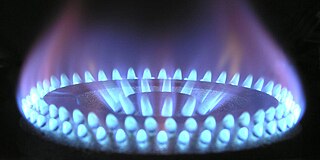
Natural gas is a naturally occurring mixture of gaseous hydrocarbons consisting primarily of methane in addition to various smaller amounts of other higher alkanes. Low levels of trace gases like carbon dioxide, nitrogen, hydrogen sulfide, and helium are also usually present. Methane is colorless and odorless, and the second largest greenhouse gas contributor to global climate change after carbon dioxide. Because natural gas is odorless, odorizers such as mercaptan are commonly added to it for safety so that leaks can be readily detected.

Energy storage is the capture of energy produced at one time for use at a later time to reduce imbalances between energy demand and energy production. A device that stores energy is generally called an accumulator or battery. Energy comes in multiple forms including radiation, chemical, gravitational potential, electrical potential, electricity, elevated temperature, latent heat and kinetic. Energy storage involves converting energy from forms that are difficult to store to more conveniently or economically storable forms.
In measurement technology and metrology, calibration is the comparison of measurement values delivered by a device under test with those of a calibration standard of known accuracy. Such a standard could be another measurement device of known accuracy, a device generating the quantity to be measured such as a voltage, a sound tone, or a physical artifact, such as a meter ruler.
Flow measurement is the quantification of bulk fluid movement. Flow can be measured using devices called flowmeters in various ways. The common types of flowmeters with industrial applications are listed below:
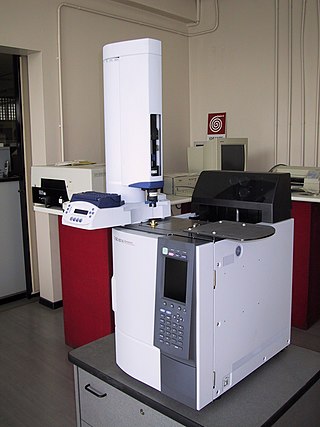
Gas chromatography (GC) is a common type of chromatography used in analytical chemistry for separating and analyzing compounds that can be vaporized without decomposition. Typical uses of GC include testing the purity of a particular substance, or separating the different components of a mixture. In preparative chromatography, GC can be used to prepare pure compounds from a mixture.
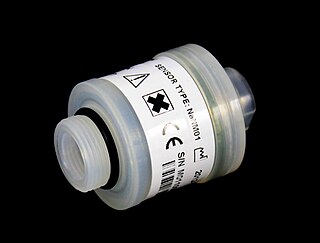
An electro-galvanic fuel cell is an electrochemical device which consumes a fuel to produce an electrical output by a chemical reaction. One form of electro-galvanic fuel cell based on the oxidation of lead is commonly used to measure the concentration of oxygen gas in underwater diving and medical breathing gases.

A mass (air) flow sensor (MAF) is a sensor used to determine the mass flow rate of air entering a fuel-injected internal combustion engine.
Enhanced oil recovery, also called tertiary recovery, is the extraction of crude oil from an oil field that cannot be extracted otherwise. Although the primary and secondary recovery techniques rely on the pressure differential between the surface and the underground well, enhanced oil recovery functions by altering the chemical composition of the oil itself in order to make it easier to extract. EOR can extract 30% to 60% or more of a reservoir's oil, compared to 20% to 40% using primary and secondary recovery. According to the US Department of Energy, carbon dioxide and water are injected along with one of three EOR techniques: thermal injection, gas injection, and chemical injection. More advanced, speculative EOR techniques are sometimes called quaternary recovery.
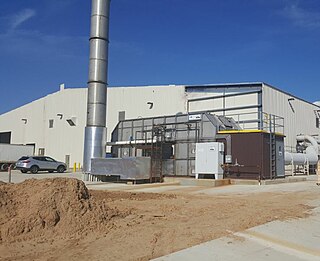
A thermal oxidizer is a process unit for air pollution control in many chemical plants that decomposes hazardous gases at a high temperature and releases them into the atmosphere.
Cabot Corporation is an American specialty chemicals and performance materials company headquartered in Boston, Massachusetts. The company operates in over 20 countries with 36 manufacturing plants, eight research and development facilities and 28 sales offices.
Soil vapor extraction (SVE) is a physical treatment process for in situ remediation of volatile contaminants in vadose zone (unsaturated) soils. SVE is based on mass transfer of contaminant from the solid (sorbed) and liquid phases into the gas phase, with subsequent collection of the gas phase contamination at extraction wells. Extracted contaminant mass in the gas phase is treated in aboveground systems. In essence, SVE is the vadose zone equivalent of the pump-and-treat technology for groundwater remediation. SVE is particularly amenable to contaminants with higher Henry’s Law constants, including various chlorinated solvents and hydrocarbons. SVE is a well-demonstrated, mature remediation technology and has been identified by the U.S. Environmental Protection Agency (EPA) as presumptive remedy.
Turndown ratio refers to the width of the operational range of a device, and is defined as the ratio of the maximum capacity to minimum capacity. For example, a device with a maximum output of 10 units and a minimum output of 2 units has a turndown ratio of 5. The term is commonly used with measurement devices and combustion plant like boilers and gasifiers.
A gas detector is a device that detects the presence of gases in an area, often as part of a safety system. A gas detector can sound an alarm to operators in the area where the leak is occurring, giving them the opportunity to leave. This type of device is important because there are many gases that can be harmful to organic life, such as humans or animals.
Continuous emission monitoring systems (CEMS) are used as a tool to monitor the effluent gas streams resulting from combustion in industrial processes. CEMS can measure flue gas for oxygen, carbon monoxide and carbon dioxide to provide information for combustion control in industrial settings. They are also used as a means to comply with air emission standards such as the United States Environmental Protection Agency's (EPA) Acid Rain Program, other US federal emission programs, or state permitted emission standards. CEMS typically consist of analyzers to measure gas concentrations within the stream, equipment to direct a sample of that gas stream to the analyzers if they are remote, equipment to condition the sample gas by removing water and other components that could interfere with the reading, pneumatic plumbing with valves that can be controlled by a PLC to route the sample gas to and away from the analyzers, a calibration and maintenance system that allows for the injection of calibration gases into the sample line, and a Data Acquisition and Handling System (DAHS) that collects and stores each data point and can perform necessary calculations required to get total mass emissions. A CEMS operates at all times even if the process it measures is not on. They can continuously collect, record and report emissions data for process monitoring and/or for compliance purposes.
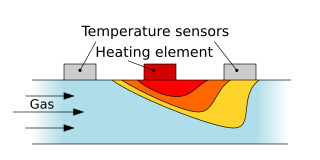
Thermal mass flow meters, also known as thermal dispersion or immersible mass flow meters, comprise a family of instruments for the measurement of the total mass flow rate of a fluid, primarily gases, flowing through closed conduits. A second type is the capillary-tube type of thermal mass flow meter. Many mass flow controllers (MFC) which combine a mass flow meter, electronics and a valve are based on this design. Furthermore, a thermal mass flow meter can be built by measuring temperature differential across a silicon-based MEMS chip.

Fluid Components International (FCI), headquartered in San Marcos, California, is a manufacturer of thermal dispersion flow and level measurement instrumentation. FCI has two divisions, one serving customers with measurement needs in industrial process and plant applications and an aerospace division, which produces level, temperature, flow and pressure sensors for aircraft manufacturers. FCI was a pioneer in developing thermal dispersion technology and holds numerous design and technology patents for its application in flow and level measurement.

The Research and Development Institute of Ecology and the Sustainable Use of Natural Resources, LLC, or Research institute of Ecology, the abbreviation is the RSI — a company from Tyumen specializes in development of innovation technologies in the field of environmental protection and nature conservation.
Gas blending is the process of mixing gases for a specific purpose where the composition of the resulting mixture is specified and controlled. A wide range of applications include scientific and industrial processes, food production and storage and breathing gases.

GE Oil & Gas was the division of General Electric that owned its investments in the petroleum industry. In July 2017, this division was merged with Baker Hughes.

A Diving rebreather is an underwater breathing apparatus that absorbs the carbon dioxide of a diver's exhaled breath to permit the rebreathing (recycling) of the substantially unused oxygen content, and unused inert content when present, of each breath. Oxygen is added to replenish the amount metabolised by the diver. This differs from open-circuit breathing apparatus, where the exhaled gas is discharged directly into the environment. The purpose is to extend the breathing endurance of a limited gas supply, and, for covert military use by frogmen or observation of underwater life, to eliminate the bubbles produced by an open circuit system. A diving rebreather is generally understood to be a portable unit carried by the user, and is therefore a type of self-contained underwater breathing apparatus (scuba). A semi-closed rebreather carried by the diver may also be known as a gas extender. The same technology on a submersible or surface installation is more likely to be referred to as a life-support system.











